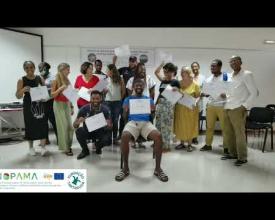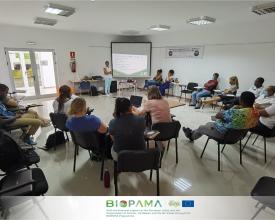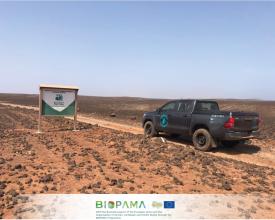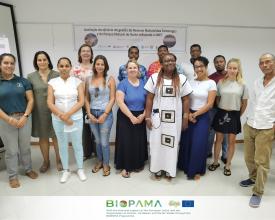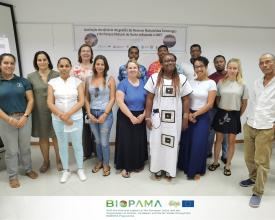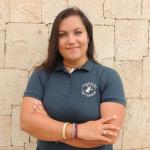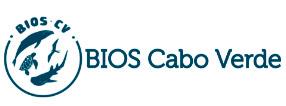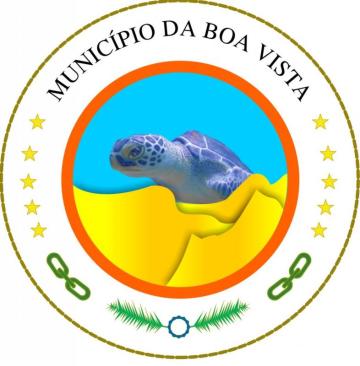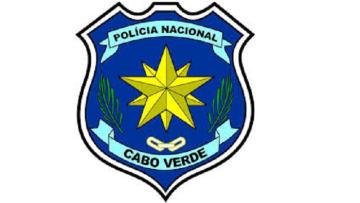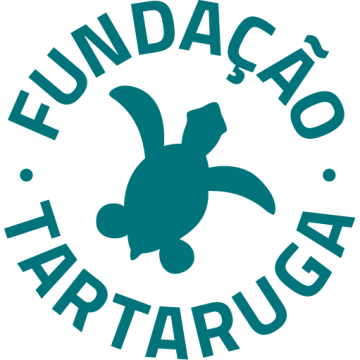
Using the IMET to identify priorities for management in two protected areas in Boa Vista, Cabo Verde

Cape Verde is an archipelago (4,030 km²) in the Atlantic Ocean 570 km west of Africa. It is recognized as a hotspot for marine biodiversity and has established 47 protected areas with the majority being designated in 2003. The process of evaluating the management of Reserva Natural das Tartarugas (RNT) and Parque Natural do Norte (PNN), located in Boa Vista island, with the Integrated Management Effectiveness Tool (IMET) in October 2021 offered key stakeholders a much greater understanding of management challenges. It provoked everyone to ask questions and broaden the knowledge available to all stakeholders regarding the stengths and weaknesses of both PAs. We were able to identify priority areas as a group and for each individual stakeholders. We identified that the PAs lack financial and personnel resources and also a lack of data regarding biodiversity and climate change monitoring. Fundação Tartaruga initiated this training in partnership with the local environmental ministry (MAA-BV) and it was funded by BIOPAMA.
Context
Challenges addressed
Cabo Verde has officially established 47 protected areas (PAs). However, the country lacks readily available data in terms of their PAs. Only 7 are registered on the World Database of Protected Areas. There is also a lack of climate, habitat, species, biodiversity and ecoregion information or misclassification.
In both sites, main threats are centrered around human-wildlife conflict including poaching and habitat degradation, marine pollution, unregulated tourist activities. The management plan and action plan for the PAs in Boa Vista are not aligned, nor are they site-specific meaning that a lot of the management objectives are not applicable to these PAs.
Location
Process
Summary of the process
All of the building blocks are necessary to make this process effective. Identifying the right stakeholders was essential, but it is clear that everyone needed to be capacited in the IMET, to be fully engaged in the process and understand the assessment results. The building block #3 - the identification of sources of data is critical as one of the main challenges of these two parks are the lack of baseline information. However, this baseline information is not available without the stakeholders (#1) and without the training of how to identify the data (#2). The interpretation of results (#4) allows us to disseminate the information gathered during the evaluation and provides the foundation for future action.
Building Blocks
1 Engaging key stakeholders
The IMET assessment is a participatory process. Therefore, in preparation for the workshop with the local ministry of environment we tried to identify stakeholders which were representative of all interested parties within the PAs. The workshop included the following stakeholders: Fundação Tartaruga (FT), Ministry of Agriculture and Environment Boa Vista (MAA-BV), BIOS CV, Cabo Verde Natura 2000, Turtle Foundation (TF), Câmara Municipal Boa Vista (CMBV), Society of Tourism Development in Boa Vista and Maio (STDIBVM), Varandinha Association, Port Maritime Institute (IMP), National Police including Maritime Police. Additionally, the national director of environment, the association for tourism operators, fisheries inspectors and further community leaders were invited but did not attend. They were informed that this is a participatory process which will allow everyone's voices and opinions to be heard and recorded in the evaluation. The vote of each representative was given equal weighting and so it was a very inclusive process.
Enabling factors
The attendance and contribution of all involved was fantastic. Members could see the idea clearly behind the tool and at the end of the workshop the results were very clear and were representative of the challenges all stakeholders face while interacting with the PAs.
Everyone was invited to participate in the online sessions to understand the process and idea of the evaluation which made the face to face sessions more effective.
Communication between the stakeholders (Portuguese-speaking) and the trainer (English-speaking) was very important.
Lesson learned
Inclusivity! In order to make the process accessible to all interested parties we had two translators present at the workshop and have translated all correspondence, reports and presentation to both Portuguese and English. This allowed local people from all different backgrounds to share their ideas and opinions on the management of their local parks and express what they believe should be done.
There is a history of poor relationships between the NGOs on the island, however this process allowed individuals representing the NGOs to be unified in presenting arguments for what they believed should be made a priority in the management of the PAs in terms of species and habitats and the ecosystem as a whole.
There is no one correct answer. An understanding of compromise is also vital in the sense that not everyone can achieve exactly what they want, those stakeholders with contrasting needs, desires or demands were faced with the opportunity to present their case, and their reasons behind it. Those stakeholders placed along the spectrum of contrasting opinion had to decide in which favour to support.
2 Training and coaching
In preparation of the evaluation, all participants were invited to and took part in two online meetings with Bertille Mayen, an IMET expert (also called an IMET coach), who taught everyone what is IMET and what the project hoped to achieve. During these online meetings she requested that all documentation relating to the PAs would be made readily available to her and to the other participants prior to the workshop.
A total of 18 people participated in the IMET training workshop. This included many different organisations and brought together people from various backgrounds with different interests.
All participants, downloaded the IMET software and experimented with using it to become familiar with the program before the in person workshop. Additional guidance and online meetings were offered by Bertille for anyone who had technical difficulties. Participants included local scientists, local town council members, local police, Masters student, members from local and international NGOs, PA manager, community member, tourism development technician and two translators.
Enabling factors
All participants were given the opportunity to learn new skills and gain new knowledge.
It allowed community members to express their fears and their hopes in a safe and controlled environment and offer them a chance to provide solutions.
An exchange of knowledge and a deeper understanding of the issues and how to address them.
Creation of a channel of communication between members the local community and the Director of Environment in the capital.
Lesson learned
- The importance of sharing information and data and making it accessible to all interested parties.
- It is critical to allow contrasting opinions and visions to be heard and use them to create ideas for change.
- All participants could learn that each stakeholder had something valuable to offer to the process.
3 Identifying sources of data
During the online and in person trainings a google drive was made where participants could upload various laws, policies and documents to aid the process. This made everything accessible to everyone and so all stakeholders could learn as little or as much as they wanted. Bertille showed everyone where to find the management plans and regulations for the protected areas. The responsibility to find specific data to present to the group was divided up and assigned to each participant.
Enabling factors
- All participants were taught how to find information including laws and objectives and where they originate. E.g. Aichi targets.
- All participants shared their knowledge with each other, it was a huge capacity building exercise.
Lesson learned
- When originally we believed that some data did not exist, during the process and by gathering incdividuals we were able to fill a lot of the knowledge gaps.
- All participants would be able to repeat the process without the guidance of a trainer in the future. Bertille provided the tools and guidance to allow all participants to gain the knowledge and decision-making abilities to replicate this process in the future. In theory this would allow any one of the participants to conduct the analysis on the same reserves in the future or on one of the other 47 PAs present within Cabo Verde. The skills and knowledge has been transferred to all 18 participants through this evaluation process.
4 Interpretation of the assessment results
Automatically the results are generated by the IMET and are easily interpreted. IMET contains several data visualization tools, based on an embedded statistical analyses. As soon as the assessment is completed, scores and bar-charts are displayed. Aspects which need attention are coloured along a colour and percentage scale. This makes it very simple ans easy to allocate resources to where they are most needed.
Enabling factors
Clear identification of priorities to focus future management, funding and resources.
Praise of the current management of resources. Even though the PAs have only around 16% of the resources i.e. personnel, materials and financing that is estimated to be required, they are achieving almost 50% in terms of outputs.
In January 2022 the national director of the environment of Cabo Verde attended an online meeting to discuss our project and findings.
Lesson learned
IMET highlighted the problems faced by the PA management team – e.g. the lack of employees. There are just three people employed to manage 14 protected areas which is beyond human capacity and really emphasised need to employ more people. 93% of the total operating budget for RNT was provided by the NGOs, and only 5.6% was provided by the government. Understanding these input aspects allows the planning of a sustainable approach to management through the implementation of eco-tourism which could provide a stable and constant income in the long-term.
We realised that there are no baseline data for the two PAs and so we do not know if pressures such as tourism or climate change are having a negative impact on the PAs as there is nothing to compare future values to. In order for the PAs to be sustainably managed, an understanding of the resources, features and ecosystems present is needed to see if any changes are occurring.
The process also highlighted the importance of the roles of the NGOs and their contribution in terms of financial, personnel and material resources.
Impacts
- Completion of management effectiveness evaluations on two PAs in Cabo Verde.
- Alignment of management priorities with the specificities of the two protected areas.
- Communication between all stakeholders has improved.
- Detailed and passionate discussions evoking empathy from various stakeholders.
There is a vast knowledge gap relating to the habitats, species, ecosystems and resources that can be found, their abundance, distribution and specifically species population trends. The IMET results highlighted this lack of information and as stakeholders in the PAs, we all now know that we need to focus research efforts on collecting data. First we need to collect baseline data for the species and habitats and then continue a monitoring program to unsderstand the health of these ecosystems.
With the results of this project it is easier to apply for focused funding with justification and evidence. We are specifically applying for the BIOPAMA Medium Grant to implement the necessary changes we identified.
Beneficiaries
- Local and national government, municipality, law enforcement agents, NGOs, Port & Maritime Institute, local communities, tour operators & tourists.
- Endemic, endangered & data deficient species.
- Nesting loggerhead turtles.
Sustainable Development Goals
Story
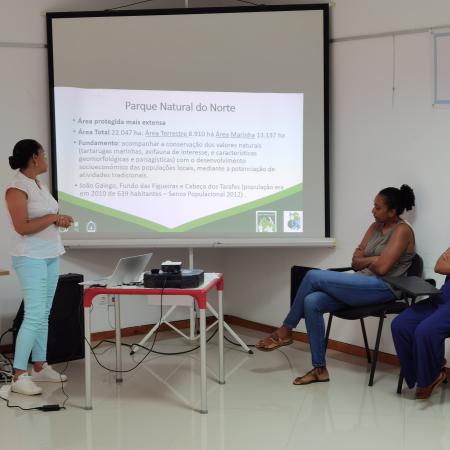
The person responsible for the management of the protected areas in Boa Vista: Ivone Monteiro Delgado really benefitted from the IMET evaluation as it enabled her to:
- Identify the threats and pressures within the PAs and evaluate their impacts and trends
- Identify measures and actions for more favourable results
- Identify weaknesses of the internal structure of the governance most importantly thelack of resources including people and materials
- Difficult to find funding due to reliance on the government and so without the NGOs on Boa Vista it would be almost impossible to implement the action plan of the PAs
- Identify that it is necessary to update the current management plan.
She would like to repeat this process on the other PAs she is responsible for in Boa Vista and also repeat the evaluation in 2023 after the implementation of further projects targetting the priority measures identified during the IMET.

